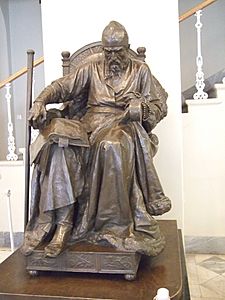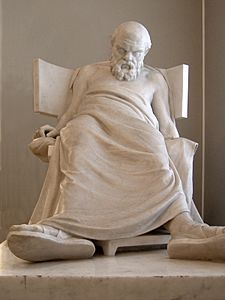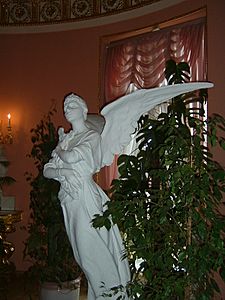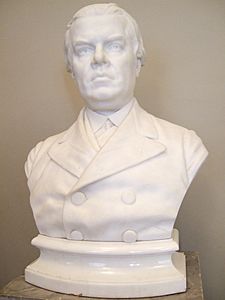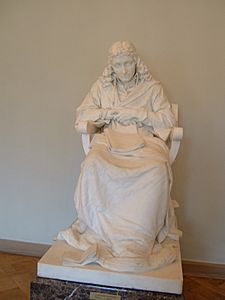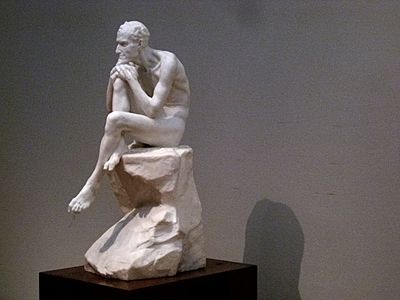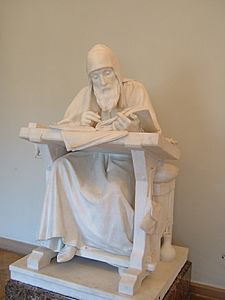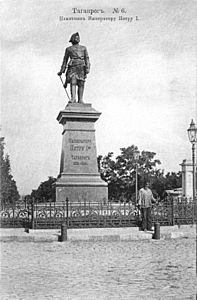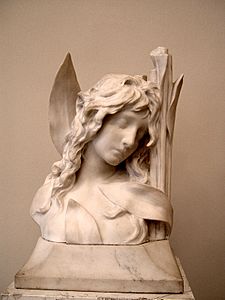Mark Antokolsky facts for kids
Quick facts for kids
Mark Antokolsky
|
|
|---|---|
| Марк Матвеевич Антокольский | |
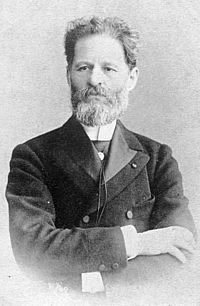
Mark Antokolsky
|
|
| Born | October 21, 1843 |
| Died | June 26, 1902 (aged 58) Bad Homburg vor der Höhe, German Empire
|
| Education | Member Academy of Arts (1871) Professor by rank (1880) Full Member Academy of Arts (1893) |
| Alma mater | Imperial Academy of Arts |
| Known for | Sculpture |
Mark Matveyevich Antokolsky (born November 2, 1840, died July 14, 1902) was a famous sculptor from the Russian Empire. He was of Lithuanian Jewish background.
Contents
Biography
Early Life and Art
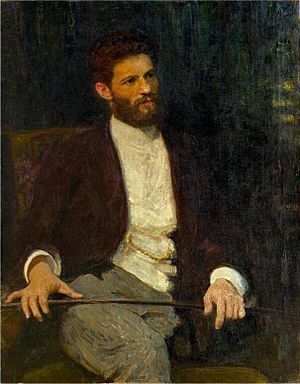
Mark Antokolsky was born in Vilnius, Lithuania. At that time, Vilnius was part of the Russian Empire. His birth name was Mordukh Matysovich Antokolsky.
He studied at the Imperial Academy of Arts in Saint Petersburg from 1862 to 1868. Early in his career, he focused on Jewish themes. Some of his first statues included "Jewish Tailor" and "The Talmudic Debate".
Moving to New Places
From 1868 to 1870, Mark Antokolsky lived in Berlin. In 1870, he created a statue of Ivan the Terrible. Emperor Alexander II of Russia bought this statue for the famous Hermitage Museum. The Emperor was very impressed and gave Antokolsky the title of Academic.
Antokolsky believed that sculpture should show important social and human ideas. Because of his health, he moved to Italy in 1871. Six years later, he settled in Paris, France.
Works on Jewish Themes
Antokolsky often returned to his hometown of Vilnius for summer holidays. In 1864, during one of these visits, he created his first important work. This was a high relief sculpture called "A Jewish Tailor".
This sculpture caused a lot of discussion at the Academy in St. Petersburg. The Academy Council decided to give Antokolsky a Small Silver Medal for his "Tailor" sculpture.
The next year, in Vilnius, he made another high relief called "A Stingy Man". This work is sometimes known as "A Stingy Jew Counting his Coins". Antokolsky came from a poor family. He saw his father's financial situation get better, and this sculpture might have shown his feelings about his hometown and his father.
A famous art critic, Vasily Stasov, praised this work. He said it showed "simple truth" that no one had dared to sculpt before. In 1865, "A Stingy Man" won the Grand Silver Medal from the Academy. Antokolsky continued to work on Jewish themes. He started complex pieces like "Talmud Dispute" and "Inquisition Attacks the Jews". "Inquisition" was his last Jewish-themed work during his student years.
Becoming an Honorary Citizen
On April 7, 1870, the Art Academy recognized Antokolsky for his "wonderful knowledge of art". He was given the special title of honorary citizen. This meant he was no longer listed in the local Jewish community records.
Famous Russian Sculptures
In 1871, Antokolsky began his first major "Russian" sculpture, "Ivan the Terrible". This artwork greatly impressed art experts. Emperor Alexander II asked for a bronze copy and paid Antokolsky 4,000 rubles in advance. Another art collector, Pavel Tretyakov, ordered a marble copy for his gallery.
The money helped Antokolsky with his personal life. In 1871, in Vilnius, he met Jelena (Gene) Apatovas, the daughter of a wealthy merchant. They got married on September 6, 1872.
Antokolsky used some of the money from "Ivan the Terrible" to buy half of a large house in Vilnius. His wife already owned the other half. In 1876, he rebuilt the house during one of his visits. After 1876, he visited Vilnius less often. This was due to his illnesses, busy work schedule, and exhibitions in Paris and Italy. Even so, he stayed connected to Jewish life. His concern for his people made him return to his unfinished work, "Inquisition Attacks the Jews". He had started this piece 30 years earlier in Vilnius.
Later Life and Legacy
In Rome, Antokolsky finished a statue of Peter the Great in 1872. This statue was for Peterhof Palace. Copies were also made for Taganrog and Archangelsk.
In 1878, Antokolsky showed many of his works at the Paris Universal Exposition. He won the Grand Prize there. In 1880, he had his own exhibition in Saint Petersburg and was given the rank of professor.
Antokolsky moved back to Paris that same year. He lived in the French capital for the rest of his life, except for some time spent near Lake Maggiore in northern Italy. In Paris, he created many more sculptures. These included "Spinoza" (1881), "Mephistopheles" (1884), "Yaroslav the Wise" (1889), "Nestor the Chronicler" (1889), and "Yermak Timofeevich" (1891). Some of his smaller sculptures are now in the European Art collection at the Israel Museum in Jerusalem.
He had also planned a monument for Catherine II in Vilnius. However, his stomach illness became very serious. He sadly passed away suddenly on July 9, 1902, in Frankfurt, Germany. Another sculptor, I. Ginzburg, finished his last work after his death. This monument no longer exists.
Antokolsky was buried in St. Petersburg. His grave and tombstone can still be found in the Jewish part of Preobrazhenskoye Cemetery.
Gallery
-
Ivan the Terrible, 1871
-
Death of Socrates, 1875
-
Spinoza, 1882
See also
 In Spanish: Mark Antokolski para niños
In Spanish: Mark Antokolski para niños


